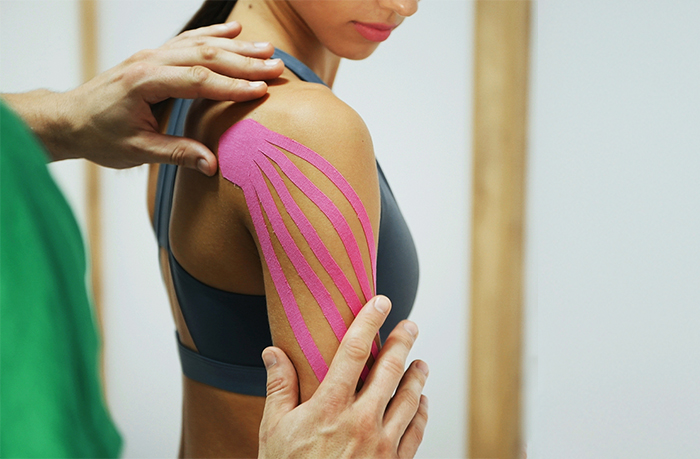Copyright © 2021 Kunshan Yuhuan Package Materials Co., Ltd. All rights reserved.
- 86 0512-50336235
- lulu@suzmc.com
- Sitemap
Discover the numerous benefits and versatile uses of kinesiology tape. This comprehensive guide provides insights into the application techniques, advantages, and frequently asked questions related to kinesiology tape. Explore how this innovative tape can enhance performance, alleviate pain, and support the body during physical activities.

Kinesiology tape, also known as elastic therapeutic tape, k-tape, sports tape, has gained immense popularity in the world of sports and rehabilitation. This flexible adhesive tape is designed to mimic the properties of human skin, providing support to muscles and joints without restricting movement. From professional athletes to weekend warriors, kinesiology tape has become an indispensable tool for optimizing performance, preventing injuries, and accelerating recovery.

Kinesiology tape has revolutionized the way athletes, patients, and fitness enthusiasts approach injury prevention and rehabilitation. With its unique elasticity and adhesive properties, this tape offers a wide range of benefits and applications. Let's delve into the core features and advantages of kinesiology tape.
Kinesiology tape provides targeted support to muscles, facilitating proper alignment and movement. By lifting the skin and creating space between the muscle and fascia, the tape reduces strain and fatigue, leading to improved muscle function and reduced risk of injury.
The application of kinesiology tape can help alleviate pain and reduce swelling caused by various conditions, such as muscle strains, joint sprains, and inflammation. The tape's gentle pressure and stimulation of sensory receptors assist in activating the body's natural pain-relieving mechanisms.
By lifting the skin, kinesiology tape enhances blood circulation and lymphatic drainage. This promotes the removal of metabolic waste and facilitates the delivery of oxygen and nutrients to the affected area, fostering a faster recovery process.
Unlike traditional rigid sports tape, kinesiology tape allows for a full range of motion. Its elasticity and stretch properties enable athletes and patients to move freely while still benefiting from the tape's support and stability.
Kinesiology tape serves as a preventive measure against injuries by providing structural support to vulnerable areas. It can be applied proactively to stabilize joints, protect muscles, and improve overall biomechanics during physical activities.
The application of kinesiology tape stimulates the sensory receptors in the skin, enhancing proprioception and body awareness. This heightened feedback helps athletes maintain better control and coordination during movements, optimizing performance and reducing the risk of falls or accidents.
Kinesiology tape offers versatile applications across various body parts and conditions. Understanding the proper techniques and strategies for applying the tape is essential for maximizing its benefits. Let's explore some common areas where kinesiology tape can be used and the corresponding application methods.
· Application Technique: Cut a strip of kinesiology tape long enough to span from the upper arm to the upper back. Apply the tape diagonally across the shoulder joint, providing support and improving stability.
· Benefits: Enhances shoulder stability, reduces pain, and improves range of motion.
· Application Technique: Cut two "Y" strips of kinesiology tape. Place the base of each strip below the kneecap and stretch the arms upward along the inner and outer sides of the thigh. This technique offers additional support and stability to the knee joint.
· Benefits: Provides stability, reduces strain, and alleviates knee pain.
· Application Technique: Cut two long strips of kinesiology tape and apply them vertically on either side of the spine, starting from the lower back and extending upwards. The tape should be stretched slightly for better support.
· Benefits: Helps alleviate lower back pain, improves posture, and provides gentle support to the muscles in the area.
· Application Technique: Cut a strip of kinesiology tape long enough to wrap around the affected ankle. Apply the tape in a figure-eight pattern, crossing over the front and back of the ankle joint for optimal stability.
· Benefits: Assists in reducing swelling, provides support, and aids in ankle stabilization.
· Application Technique: Cut a strip of kinesiology tape and apply it horizontally over the affected area of the forearm, just below the elbow joint. Apply slight tension to the tape to stimulate the sensory receptors.
· Benefits: Helps alleviate pain and provides support to the forearm muscles.
· Application Technique: Cut a strip of kinesiology tape and apply it vertically along the arch of the foot, starting from the heel and extending towards the toes. Apply the tape with gentle tension to support the arch.
· Benefits: Assists in reducing pain, supports the arch, and relieves stress on the plantar fascia.